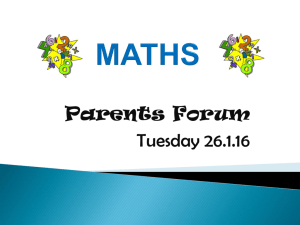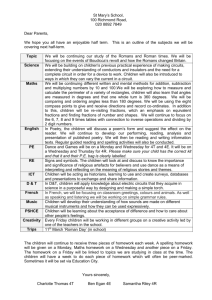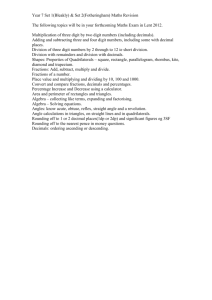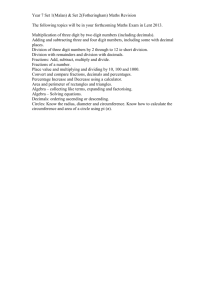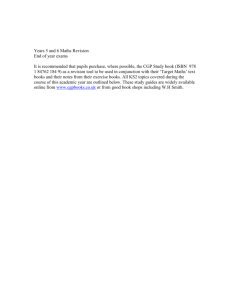National Curriculum 2014
advertisement
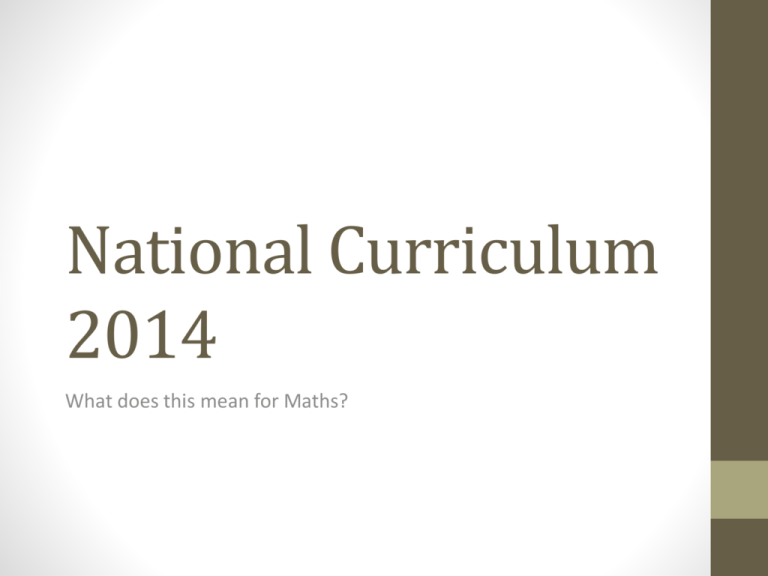
National Curriculum 2014 What does this mean for Maths? Why has the national curriculum changed? As the Department for Education puts it, it’s all about trying to compete in the global economy and the curriculum 2014, “combines the best elements of what is taught in the world’s most successful school systems, including Hong Kong, Massachusetts, Singapore and Finland, with some of the most impressive (existing) practice from schools in England.” The aim is to equip children with the top-class knowledge and skills that universities and employers demand. What does this mean for Maths? The following information has been taken directly from the New National Curriculum Purpose of study Mathematics is a creative and highly inter-connected discipline that has been developed over centuries, providing the solution to some of history’s most intriguing problems. It is essential to everyday life, critical to science, technology and engineering, and necessary for financial literacy and most forms of employment. A high-quality mathematics education therefore provides a foundation for understanding the world, the ability to reason mathematically, an appreciation of the beauty and power of mathematics, and a sense of enjoyment and curiosity about the subject. The national curriculum for mathematics aims to ensure that all pupils: • become fluent in the fundamentals of mathematics, including through varied and frequent practice with increasingly complex problems over time, so that pupils have conceptual understanding and are able to recall and apply their knowledge rapidly and accurately to problems • reason mathematically by following a line of enquiry, conjecturing relationships and generalisations, and developing an argument, justification or proof using mathematical language • can solve problems by applying their mathematics to a variety of routine and non-routine problems with increasing sophistication, including breaking down problems into a series of simpler steps and persevering in seeking solutions. When is Maths taught? Maths is a core subject with a range of cross-curricular links (e.g. data handling in Science, measures in Geography) but most often, is best taught discretely, using opportunities from other subjects to rehearse skills in a context. Our policy is that Maths is taught for one hour a day and we are planning in opportunities for Maths to become topic based and used across all areas of the curriculum. What has changed? At a glance… Changes to the Maths Curriculum: Year 1 What’s gone? What’s been added? Data Handling/Statistics Counting & writing written numerals to 100 No specific requirement to describe patterns Write numbers in words up to 20 No specific requirements to describe ways of solving problems or explain choices Number bonds secured to 20 Use of vocabulary such as equal, more than, less than, fewer etc Changes to the Maths Curriculum: Year 2 What’s gone? What’s been added? Rounding two-digit numbers to the nearest 10 Solving problems with subtraction (not just addition) Halving/doubling no longer explicitly required Finding/writing fractions of quantities (and lengths) Using lists/tables/diagrams to sort objects Adding two 2-digit numbers Adding three 1-digit numbers Demonstrating commutativity of addition and multiplication Describing properties of shape (e.g. edges, vertices) Measuring temperature Tell time to the nearest 5 minutes Make comparisons using <>= symbols Recognise £ p symbols and solve simple money problems Changes to the Maths Curriculum: Year 3 What’s gone? What’s been added? Specific detail of problem solving strategies (although the requirement to solve problems remains) Adding tens or hundreds to 3-digit numbers Rounding to the nearest 10/100 moves to Year 4 Formal written methods for addition/subtraction Reflective symmetry moves to Year 4 8 times table replaces 6 times table Converting between metric units moves to Year 4 Counting in tenths No requirements to use Carroll/Venn diagrams Comparing, ordering, adding & subtracting fractions with common denominators Identifying angles larger/smaller than right angles Identifying horizontal, vertical, parallel and perpendicular lines Telling time to the nearest minute including 24 hour clock and using Roman numerals Know the number of seconds in a minute, days in a each month, year and leap year Changes to the Maths Curriculum: Year 4 What’s gone? What’s been added? Specific detail on lines of enquiry, representing problems .strategies to solve problems and explaining methods Solving problems with fractions and decimals to two decimal places Using mixed numbers (moved to year 5) Rounding decimals to whole numbers Most ratio work (moved to year 6) Roman numerals to 100 Written division methods (moved to year 5) Recognising equivalent fractions All calculator skills removed from KS2 Knowing equivalent decimals to common fractions Measuring angles in degrees (moved to year 5) Dividing by 10 and 100 Using factor pairs Translation of shapes Finding area/perimeter of compound shapes Solve time conversion problems Changes to the Maths Curriculum: Year 5 What’s gone? What’s been added? Detail of problem-solving process and data handling cycle no longer required Understand, use and solve problems involving decimals with 3 dp Calculator skills (moved to KS3) Write percentages as fractions; fractions as decimals Probability (moves to KS3) Use vocabulary of primes, prime factors, composite numbers, etc Know prime numbers to 20 Understand square and cube numbers Use standard multiplication and division methods for up to 4 digits Add and subtract fractions with the same denominator Multiply proper fractions and mixed numbers by whole numbers Deduce facts based on shape knowledge Distinguish regular and irregular polygons Calculate the mean average To sum up… • Fractions are introduced earlier, multiplication tables up to 12x are expected by age 9 • There is an increased emphasis on practice. “So pupils develop the ability to recall and apply knowledge rapidly and accurately” • Calculators are out! – to be replaced by “mental fluency and the use of efficient written methods in the four mathematical operations” • The National Curriculum Levels are out! – Schools will be free to decide how to report to parents on children’s progress. How can I help my child at home? - Praise! Praise! Praise! Make it fun! Games/puzzles/jigsaws/songs Make it practical! Make it relevant ! Show how we use maths skills in our everyday lives and involve your child in this. - Make it noisy! If your child is stuck talk it through. Use mathematical vocabulary. - Times Tables – top tips for times tables/apps/songs/websites - Number bonds – apps/websites/games Useful website • http://webarchive.nationalarchives.gov.uk/20110202093118/ http:/nationalstrategies.standards.dcsf.gov.uk/node/85273

